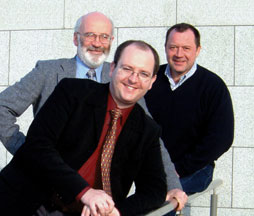| 2003 |

|
YEAR BOOK |
Dublin City University
|
ZnO-based material systems for ICT applications
|

Zinc Oxide (ZnO) is a semiconductor material that emits light in the blue end of the spectrum (or even the near ultra-violet). The development of laser diodes and light emitting diodes (LEDs) capable of reliably and efficiently emitting blue light is one of the most sought-after goals in optoelectronics technology. Such emitters offer a dramatic increase in data storage capacity. The blue light may be focussed to a smaller spot size and hence it may be possible to fit five or six times more 'bits' of information into the same area.
There are significant scientific problems in actually making devices based on ZnO. In order to make semiconductors useful for devices, it is vital to enable them to conduct electricity. This can be done in two ways, so called n-type and p-type doping, where appropriate elements (e.g. aluminium and nitrogen, n- and p-type dopants respectively) are carefully introduced in the material in minute amounts. By sandwiching together n- and p-type regions in appropriate combinations one makes a whole array of devices, including transistors, LEDs etc.
While normal semiconductors such as silicon may be doped relatively easily, it is very difficult to dope ZnO p-type, and hence there has been little or no progress in developing working devices based on this material. One of the main aims of this work is to achieve high levels of p-type doping. Our work will be guided by recent theoretical studies of the corresponding mechanism. We will use the technique known as Pulsed Laser Deposition (PLD) to grow ZnO thin films around 200nm thick (approximately five hundredths the width of a human hair) to test these theoretical predictions and to explore new routes towards successful p-type doping. We will thence grow prototype LEDs and laser diodes as device demonstrators.
We will also explore new ways of growing ZnO in tiny wire-like structures (nano-wires) which have a diameter of about 50nm, which will dramatically improve the efficiency of the conversion of electrical energy into light energy.
Contact: Dr Jean-Paul Mosnier; Tel: 01-7005303; E-mail: [email protected]